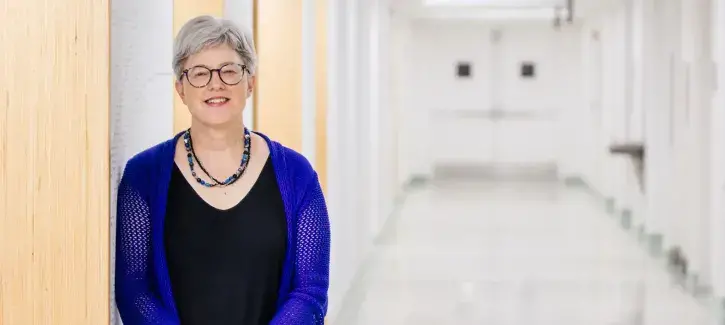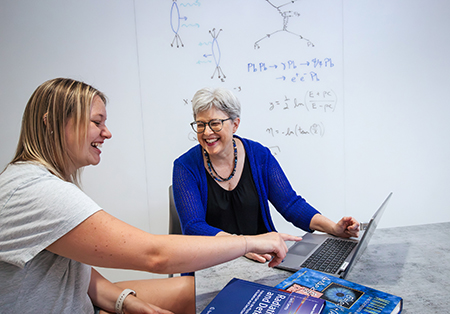
Creighton physics professor Janet Seger receives 2025 Breakthrough Prize for CERN research

Janet Seger, PhD, longtime professor in Creighton University’s Department of Physics, has been named a 2025 recipient of the prestigious Breakthrough Prize in Fundamental Physics for her research as part of the ALICE Collaboration at CERN’s Large Hadron Collider (LHC). Known as the “Oscars of Science,” the Breakthrough Prize honors transformative advances in the life sciences, mathematics and fundamental physics.
Exploring the Early Universe at CERN’s Large Hadron Collider
Seger, who joined Creighton’s faculty in 1991, has dedicated her career to high energy nuclear physics, with a research focus on relativistic heavy ion and ultraperipheral collisions. Her work at CERN, the European Organization for Nuclear Research based in Geneva, Switzerland, has helped unlock insights into the quark-gluon plasma—a state of matter thought to have existed in the first microsecond after the Big Bang.

“It’s an exciting privilege to be able to learn new things about the smallest building blocks of the universe,” she says.
The 2025 Breakthrough Prize celebrates the collective efforts of four experimental collaborations at CERN—ALICE, ATLAS, CMS and LHCb—which together include researchers from over 70 countries. ALICE (A Large Ion Collider Experiment), of which Creighton has been a member since 2002, specializes in exploring conditions of extreme temperature and density, recreating early-universe matter in laboratory conditions.
“Creighton has a long history of participation at the cutting edge of high energy physics,” says Seger. “This prize represents some public recognition for the value of that work.”
A Lifelong Passion for Physics
Seger’s path to physics began with inspiration from her high school teacher, Mr. Gunther, and was reinforced by the intellectual challenge of college physics courses. After earning her BS from Grinnell College and her MS and PhD from the University of Wisconsin–Madison, she came directly to Creighton, where she has been ever since.
“I really enjoy the beauty of using just a few general principles to explain and understand the wide variety of phenomena we see in the physical world around us,” she says of her fundamental love of physics.
Innovations in Ultraperipheral Collision Research
During her tenure at Creighton, Seger has participated in the STAR Collaboration at Brookhaven National Laboratory and joined the ALICE Collaboration in 2012. More recently, she became part of the ePIC Collaboration, developing a detector for a next-generation collider also at Brookhaven.
Within ALICE, Seger’s team specializes in ultraperipheral collisions—rare near-miss events where ions pass close enough to interact electromagnetically yet not close enough to physically collide. These interactions provide a unique laboratory for probing the internal structure of nuclei in extreme conditions.
“Ultraperipheral collisions allow us to study nuclei, which are composed of protons and neutrons—often thought of as distinct ‘marbles’—without breaking them apart,” she explains. “We see evidence that nuclei have properties that differ from what we would expect if the protons and neutrons within nuclei were, in fact, distinct ‘marbles.’ Explaining these results helps constrain our understanding of the inner structure of the protons and neutrons.”
Mentoring the Next Generation of Physicists
Both undergraduate and master’s level students at Creighton have played significant roles in this research. Under Seger’s guidance, they have written code for remote detector monitoring, staffed data-taking shifts at Brookhaven and CERN and contributed to data analysis. One student is currently exploring machine learning applications to enhance searches for new physics in heavy ion collisions.
“Creighton’s continued support for this work has meant that students, post-docs and faculty have had the opportunity to work at the forefront of high energy physics. Our students work alongside scientists from all over the world, doing the same work that would often be done by a PhD student or even a post-doc at other institutions,” Seger says.
Contributing to Global Physics Tools and Simulations
As part of her broader impact, Seger’s group also contributes to the development and refinement of the STARlight Monte Carlo simulation—a widely used computational tool for modeling ultraperipheral heavy ion collisions. The software aids researchers across collaborations in calibrating detectors and exploring new physics phenomena.
CERN, while based in Europe, maintains cooperative agreements with U.S. institutions, enabling American scientists and universities to participate in its global research efforts. Thanks to remote capabilities and strategic partnerships, Creighton researchers can contribute extensively without the need for continuous travel, although some students and postdoctoral scholars do spend extended periods at CERN.
Recognizing the Value of Fundamental Research
Reflecting on the honor, Seger says, “It’s wonderful to see the value of fundamental research being recognized.” The Breakthrough Prize underscores the global significance of research like hers—work that deepens our understanding of the universe at its most basic level and affirms Creighton’s place in the international scientific community.




